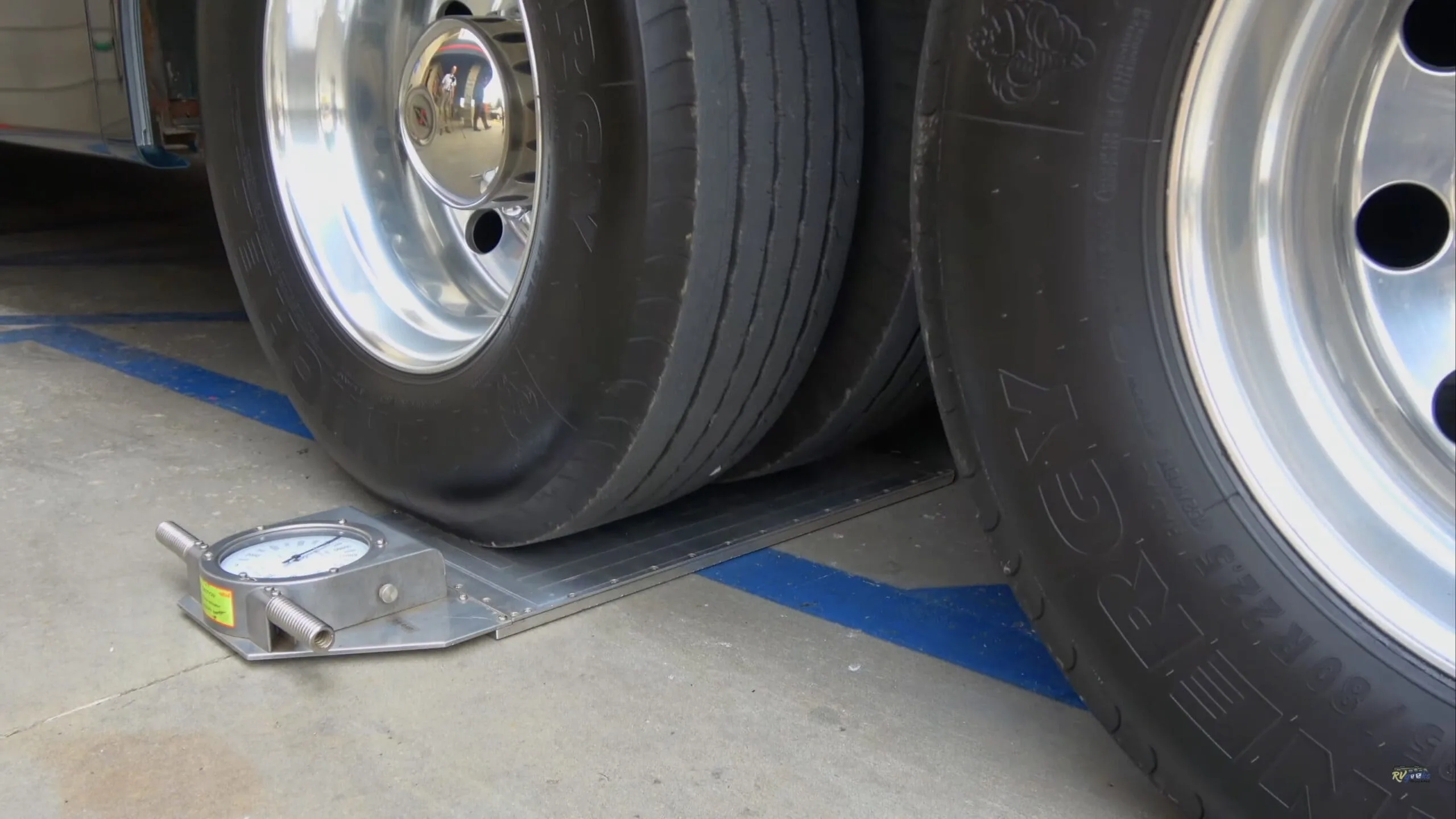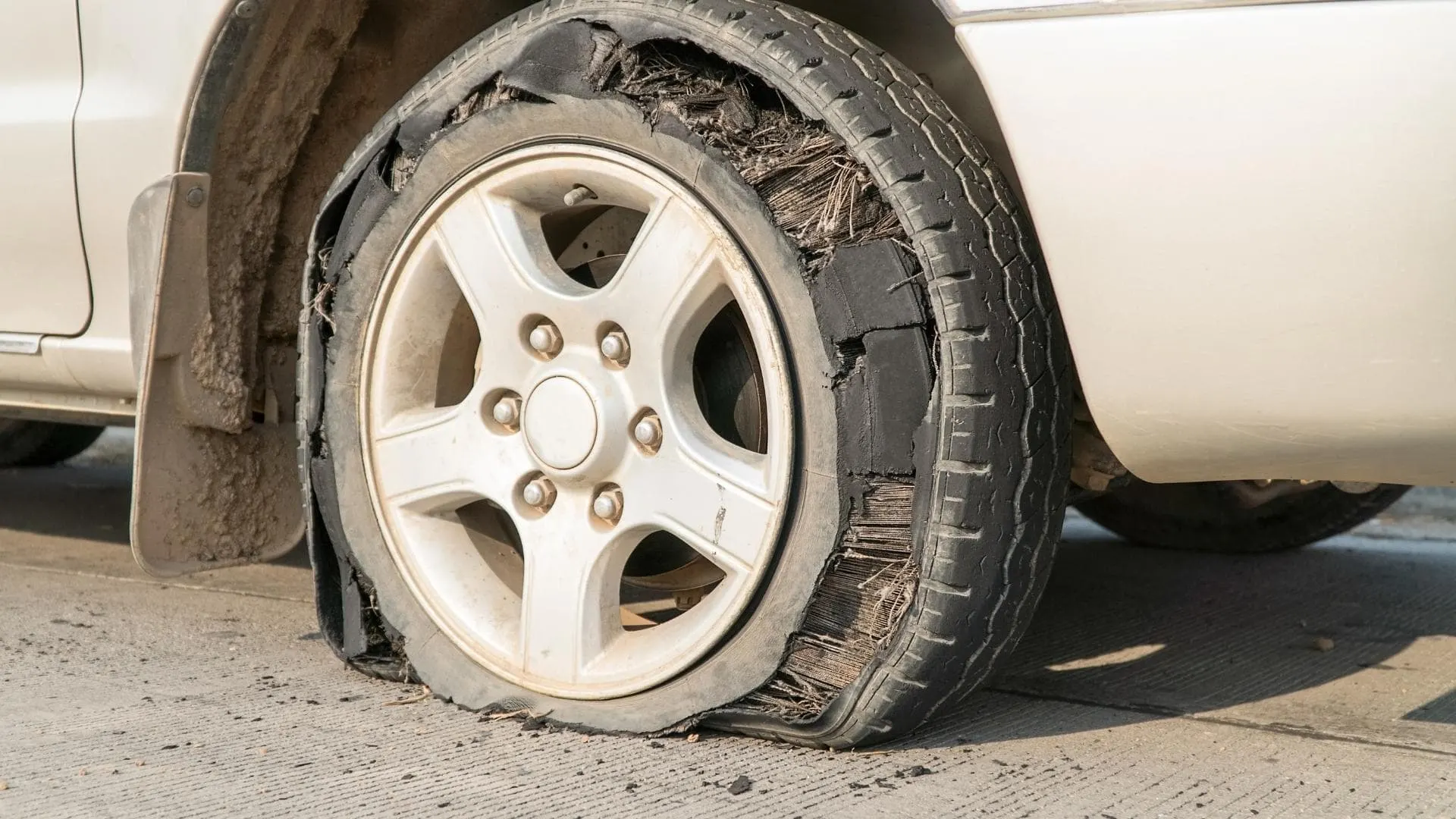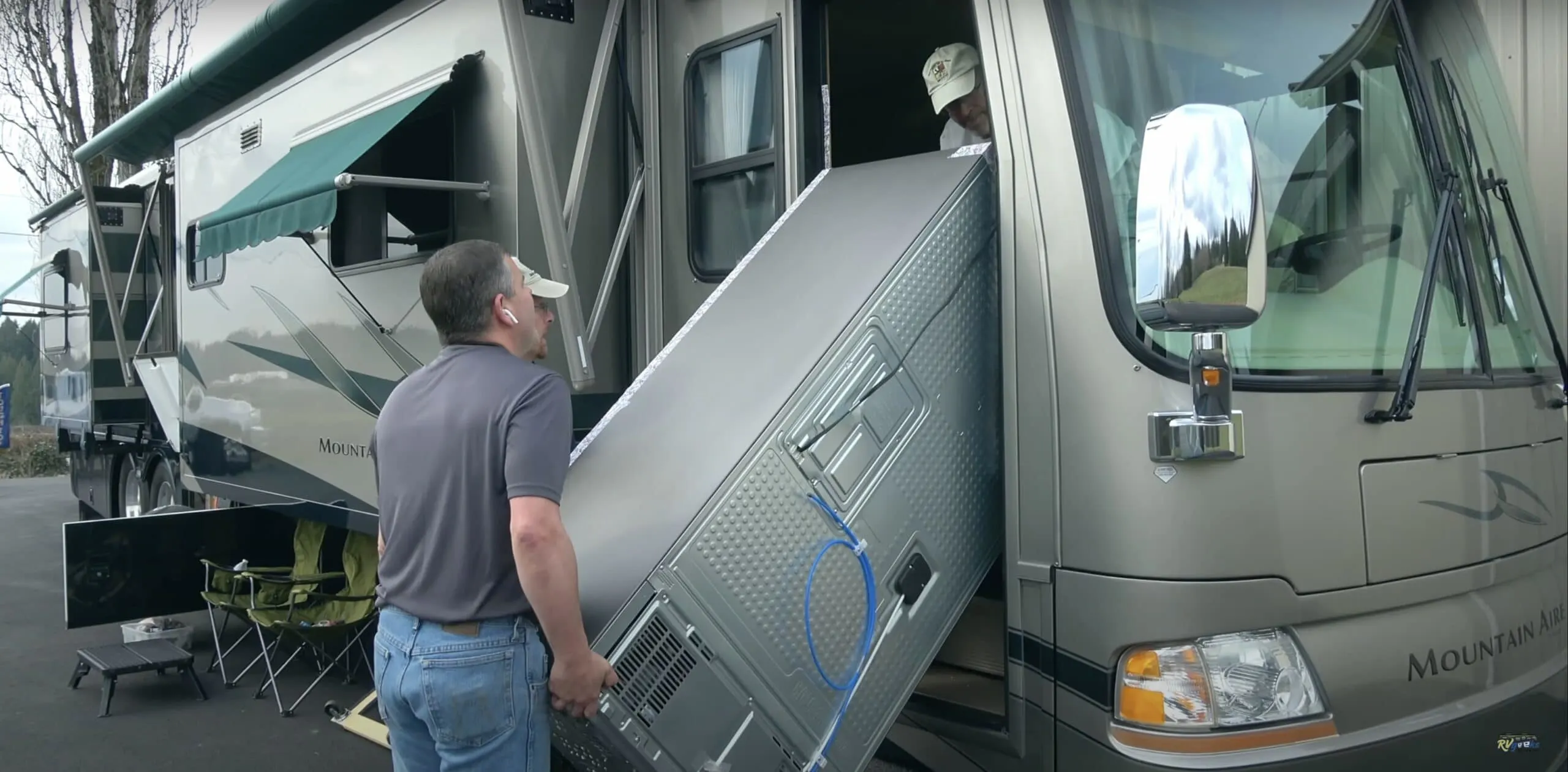You’re likely well aware that the safety of your RV and, more importantly, that of you and your family, are riding (literally) on your RV’s tires. Despite the importance of the topic, RV tire pressure is among the most widely misunderstood aspects of RVing. How is it that the details of such a critical safety consideration are still a mystery to so many RVers?
We’ve talked to an awful lot of RVers who clearly aren’t sure how to determine the correct pressures for their RV’s tires (even some seasoned full-timers who’ve been out here for a long time). So we realized the importance of shedding some additional light on the topic.
When we decided to write a blog post about this incredibly important topic, we quickly realized that there’s too much to cover in one of our regular articles. The topic is far too important to generalize, so we decided to take the time to write a more detailed piece about it. Hence our new eBook: How To Inflate RV Tires Pressures Correctly.
So, this blog post will serve as an introduction to, and overview of, our eBook. Even if you’re a seasoned RVer, we’re confident you’ll likely pick up some additional details about RV tire pressure in the book. So we highly encourage everyone to grab their free copy and follow our step-by-step guide to setting the safe and proper pressures for the tires on your RV. Even if you think you already know what they should be, you might just be surprised!
In an effort to get this important information out to as many RVers as possible, we’re making the book available for FREE right here on our website to all of our subscribers. If you’re already subscribed to our newsletter, you should have received a special e-mail with a link to access the book.
If you’re new to our blog, first of all… Welcome! To access the book, simply subscribe to receive our daily newsletters, and you’ll get immediate access to it. If you haven’t already subscribed using one of the pop-up links on the website, you can click here to subscribe. Of course, we hope you’ll appreciate the information you’ll receive in our daily articles (typically published about 5 times per week), but you can unsubscribe at any time (every email includes an unsubscribe link at the bottom).
Further down in this post, we’ll also tell you about special discounts on our favorite air compressors and tire covers. Plus, you’ll also find the entry form for our May, 2022 RVgeeks Giveaway, where one lucky person will win a top-of-the-line Viair 450P-RVS air compressor valued at over $400!
First, let’s run through an overview of this important topic by answering some common questions related to RV tire pressure.
- 1) Aren’t the Correct RV Tire Pressure Settings For My Rig Stamped Right on the Tires?
- 2) Does Every Tire On the RV Get Inflated to the Same Pressure?
- 3) How Do I Know If I’m Getting an Accurate Reading?
- 4) What Are the Potential Consequences of Setting My RV Tires to the Wrong Pressure?
- 5) Can I Set and Forget My RV Tire Pressures?
- 6) Once I Know My RV’s Safe and Proper Tire Pressures, How Can I Keep My Tires Properly Inflated on the Road?
-
7)
What Should I Do to Maintain My RV Tires?
- 7.1) Maintain Proper RV Tire Pressure
- 7.2) Use an Infrared Digital Temperature Gun to Check Tire Temperatures
- 7.3) Use High-Quality Tire Covers
- 7.4) Use a Good Quality Tire Cleaner and UV Protectant
- 7.5) Carry a High-Quality Compressor to Keep Tires Properly Inflated At All Times, Temperatures, and Elevations
- 8) Properly Inflating and Maintaining the Tire Pressures on Your RV is Critical
- 9) Enter Our Latest RVgeeks Giveaway!
Aren’t the Correct RV Tire Pressure Settings For My Rig Stamped Right on the Tires?
No! In fact, this is probably the most common of all the many misconceptions about how to correctly set RV tire pressure. That’s the maximum cold inflation pressure a tire is rated for, and may or may not be anywhere near where they should be set. (When tires are hot, pressures will read higher, which is normal, so never let air out based on any PSI reading shown when tires are hot. More about “cold” tire pressure readings below.)
Following are three of the most common misconceptions regarding how to determine the proper pressures for your RV tires:
- Correct tire pressures are stamped into the tire sidewall.
- Correct tire pressures are printed on the placard inside my RV.
- Correct tire pressures are found in the owner’s manual.
It’s likely that none of these are accurate. And these are just a few of the common misconceptions about the correct pressure settings required for your RV’s tires.
How about other RVs that are just like yours? The correct pressures for your RV’s tires aren’t necessarily the same as they are for any other RV. Not even one of the exact same year, make, and model.
The correct RV tire pressures for your rig are specific to your RV and your RV only. One of the primary factors that determine correct RV tire pressure is weight. But don’t head off to the nearest truck stop to get your rig weighed, since their scales aren’t designed to get the weights needed. That’s right… we said weights. Plural.
Corner (or “Position”) weights need to be taken before the proper RV tire pressures can be determined. It’s not rocket science, but that information is required to correctly determine your tire pressures and is critical for your safety on the road.

In order for the proper RV tire pressures to be determined, corner or “position” weights must be taken.
Once you have the weights for your RV, you’ll need one other crucial piece of information – the load & inflation table for your specific make, model and size tire. Without that and your weights, you’re mostly shooting in the dark when it comes to setting the correct pressure in your RV’s tires.
Does Every Tire On the RV Get Inflated to the Same Pressure?
This is another widely misunderstood issue. In some cases, the tires might all be set the same. But often some tires can require VERY different pressure settings than other tires on the same RV. (Fun fact… some tires on our RV call for 30 PSI less than others!)
Once you run through the process of determining the appropriate pressures for your RV’s tires, you’ll find that the settings will often be different for each axle. But without going through the proper calculation of correct tire pressure… you simply won’t know!
How Do I Know If I’m Getting an Accurate Reading?
This is another very important question. Of course, you’ll need a reliable air pressure gauge. But the timing of your readings is key. You need to get COLD inflation pressures. It’s the only way to get an accurate reading. But what does “cold” mean?
While driving of course heats tires up, there are more factors in play than simply checking tires before you drive your rig. What are the effects of other causes of tire heating? (Think direct exposure to the sun.) They’re considerable, and we go into detail in the book about how to ensure that your readings are accurate.
What Are the Potential Consequences of Setting My RV Tires to the Wrong Pressure?
There are a number of potential problems that can come from setting your RV’s tires to the wrong pressure, none of which you want to experience.
Some of the possible consequences of driving/towing your RV with incorrect pressure include:
- Uneven Tire Wear
- Poor Handling
- Reduced Ride Quality
- Lower Fuel Economy
- A Blowout! ????
Some of these are the result of tire pressures that are set too high, but the most serious risks come from pressures that are too low.

Tire pressures that are set incorrectly can cause a number of issues, including a dangerous tire blowout.
Can I Set and Forget My RV Tire Pressures?
No. Besides the obvious reduction in pressure that’s due to a slow leak, tire pressures are affected by both ambient temperature and elevation. So, depending on where and when you’re RVing, your tire pressures are likely to fluctuate to some degree. And again, that means the cold pressure fluctuates.
Also, tire pressure requirements can change on the same RV over time, depending on how the rig is loaded… or if you make modifications. Since pressure settings are directly related to weight, that means that adding, removing, or rearranging things in your rig can change the pressure requirements on the same RV.
Remember – the weight of your RV is a key factor in setting the proper tire pressures. And we’re not talking about a general weight such as that which you might get at a truck stop weigh station. Again, the corner/position weights of your RV are required.
Once you’ve determined your corner/position weights, unless you make dramatic weight changes (such as adding a new appliance, furniture, solar panels, etc.), then external changes such as ambient temperature or elevation may be the primary factors that affect cold inflation pressure. That is, assuming a tire hasn’t developed a slow leak. And you know what they say about assuming.

If the weight of your RV changes – for example, if you add a new appliance or otherwise significantly change the weight or weight distribution in the RV – your rig may need to be reweighed and the correct tire pressures recalculated accordingly.
Once I Know My RV’s Safe and Proper Tire Pressures, How Can I Keep My Tires Properly Inflated on the Road?
When we hit the road in our first RV nearly 20 years ago, we’d never been in an RV before. So we didn’t know much of anything about it. We figured we’d just head to a gas station and fill the tires to the PSI stamped on the tire sidewall.
Not only were we planning to add far more pressure than our rig required (we thought, incorrectly, that the 120 PSI on the tire sidewall was the way to go), but little did we know that most gas stations don’t have an air compressor that can come close to filling large RV tires like ours. And that would have been true even if we hadn’t been planning to over-inflate them.
Like the air pressure requirements on our first rig (and we do mean the correct settings), the tires on our current RV require far higher pressures than most gas station air compressors can supply.
You might think this problem is unique to owners of big Class A diesel pushers like ours. But one of our best friends has the exact same issue with her Class B Roadtrek, whose tires require up to 80 PSI. Just like our early experience, she drove to a local gas station and found that the compressor there didn’t stand a chance. Like us, she ended up letting air out!
So, this is a very common issue, and it’s the reason why we (and our friend) carry a Viair portable air compressor. This way, wherever we are, we can take a COLD pressure reading using our digital tire pressure gauge, and inflate as needed without even moving the RV.
If you’re interested in carrying a digital tire pressure gauge, we’ve had this one for years and just love it. (We keep a second one in our toad’s glove compartment.)
- Heavy duty construction and rugged design for long lasting use
- Angled head and rubber coated handle for easy gripping
And we can’t rave enough about our Viair 450P-RVS. Stay tuned, and down below we’ll show you how to enter for a chance to win one absolutely free (a value of over $400) in our latest RVgeeks Giveaway!
What Should I Do to Maintain My RV Tires?
It’s so important to maintain your RV’s tires. Safety is the most important reason, of course, but RV tires can also be very expensive. So we do whatever we can to take good care of them, helping reduce the frequency with which they need to be replaced.
When it does come time to replace your tires, we suggest taking advantage of the Escapees Tire Discounts. What? You’re not a member? (We’ll pretend we didn’t hear that.) We highly recommend joining Escapees. And while you’re at it, you should use our affiliate link to sign up. That’s because we donate 100% of the proceeds to the Escapees CARE Center, an incredibly worthwhile charity that helps RVers in need.
Following are five key things you can do to optimally maintain your RV tires:
Maintain Proper RV Tire Pressure
The number one most critical action you can take to keep your tires in optimal condition is to learn how to determine the correct air pressure for all of your RV’s tires and then monitor and maintain it.
We cover all the details about exactly how to do that in our eBook (signup to receive our newsletters to get your copy). Regardless of what type of RV you have (towable or motorized), we provide a step-by-step guide showing you how to identify and set the correct tire pressures for your RV. We also answer some additional common questions and explain how to optimally maintain your RV’s tire pressures.
Use an Infrared Digital Temperature Gun to Check Tire Temperatures
Among its many uses, a digital temperature gun allows you to keep an eye on the temperatures of your RV tires, even as you’re traveling. When you stop for fuel, or a rest break, give your tires a quick check. An abnormal tire temperature may alert you to pending trouble before it happens. There are so many other uses for it that you’ll love having one around your RV.
- Wide Temperature Range: Measure an upgraded temperature range from -58°–1130°F / -50°–610°C and get your result in 500 ms; The display will...
- Professional EMS Mode: The Lasergrip 1080 Infrared Thermometer has an emissivity range of 0.1–1.0 for precise readings across different surfaces and...
Use High-Quality Tire Covers
You may have read our post about why we love our new RV tire covers and which ones are our favorites. A good quality tire cover extends the life of your RV tires and this alone makes them well worth the investment.
We consider RV tire covers to be an essential piece of RV gear. In fact, we love our new tire covers so much that we even made a video about them.
SnapRing TireSavers by Covercraft are hands down the best RV tire covers we’ve had in our two decades of RVing. Heck, they’re the best we’ve ever seen… by a lot!
Not only do they offer excellent protection for our very expensive RV tires, but they’re a snap to use (hence the name). And the easier a piece of gear is to use, the more likely we are to use it, even for shorter stays.
You can pick up a set of our favorite tire covers on Amazon (they come in different sizes, so be sure to get the set that matches your tire diameter)!
Use a Good Quality Tire Cleaner and UV Protectant
We love 303 products for our RV tires. The tire cleaner makes road grime and brake dust run right off like nothing you’ve ever seen. Seriously! And the protectant provides superior UV protection that helps prevent fading and cracking while repelling dust and dirt. And it leaves just the right amount of shiny, which is to say “not too much!”
Using products like these helps to extend the life of your tires and keeps them in optimal condition across the miles.
- Watch dirt and grime dissolve quickly and easily with our color changing foam formula
- Prevents and removes tire browning, tire blossoming, and dry rot
- Ultimate Protection – 303 Aerospace Protectant provides superior protection against damaging UV rays. This protector spray repels dust, lint, and...
- Non-Greasy – Dries to a smooth, matte finish with no oily or greasy residue. When treating your outdoor furniture, spa and pool covers, vinyl...
Carry a High-Quality Compressor to Keep Tires Properly Inflated At All Times, Temperatures, and Elevations
Again, our air compressor brand of choice is Viair. We love ours and wouldn’t be without it for a number of reasons.
The 400P-RVS and 450P-RVS, Viair’s top-of-the-line compressors, are designed specifically with RVers in mind. The 450 has a 100% duty cycle which makes it the perfect compressor for RVers to carry because you don’t need to let it rest while filling tires.
That’s especially helpful for off-road enthusiasts. When you air down your Jeep tires for a trip into the sand, you need to be able to run your compressor for a long time to fill them back up for road driving. That’s where the 100% duty cycle comes in really handy.
Whether you’re airing up after an off-road adventure, or just topping up your tires on a cold morning, a compressor like our Viair 450P-RVS does the job quickly and efficiently. It also comes with extra-long hoses for the longest RVs, and an attachment that lets us fill our tires while standing up, which is a real knee-saver!
We’ve also used a Viair compressor to winterize our RV. Overall, it’s one of our favorite pieces of RV gear.
After all the years we’ve been waxing poetic about Viair, we’re happy to announce that for the very first time, we’re able to offer a special discount on their best compressors. We’ve partnered with Viair, MobileMustHave and TechnoRV to offer a 5% discount.
Use the discount/promo code RVGEEKS at either of the following links to save 5% on your own Viair compressor (not to mention all the other great RV gear they both sell. The RVGEEKS code is good for 5% off your entire order at both stores)!
TechnoRV.com is a supplier of leading RV technology products that are designed to enhance your RV lifestyle. That includes items like LevelMatePRO, Viair portable air compressors, connectivity...Show More
TechnoRV.com is a supplier of leading RV technology products that are designed to enhance your RV lifestyle. That includes items like LevelMatePRO, Viair portable air compressors, connectivity equipment, and more!
Use the Promo Code "RVGEEKS" to save 5% on your entire order at TechnoRV.
Show LessThanks to the latest additions to our RV internet arsenal from MobileMustHave, we're able to stay connected more reliably... and more remotely... than we ever could before. We couldn't be happier...Show More
Thanks to the latest additions to our RV internet arsenal from MobileMustHave, we're able to stay connected more reliably... and more remotely... than we ever could before. We couldn't be happier with the equipment we now have!
Upgrade your RV internet connectivity with great products from Peplink, WeBoost, Parsec, Poynting, Mobile Mark, and more. And while you're there, look at other great products like Viair Compressors!
Watch our video about our RV internet connectivity solutions for 2021
Save 5% on your equipment order at MobileMustHave.com when you click the button on this deal or use discount code "RVGEEKS" at checkout!
Show LessProperly Inflating and Maintaining the Tire Pressures on Your RV is Critical
Again, because this topic is too much to cover in a short blog post, we took the time to write an entire eBook about it. We hope that we might contribute to the safety of as many RVers as possible.
Properly inflating and maintaining the tire pressures on your RV is so important that we highly encourage you to sign up to receive your copy of our FREE eBook right now — How To Inflate RV Tires Pressures Correctly.
Every RVer needs to understand this information and put it into practice. If you’re already a subscriber to our newsletter, you should already have received a special invitation to access your free copy of the book.
If you’re not already a subscriber, sign up today! Not only will you receive our free eBook, but also our daily RVing articles in your inbox. We cover a wide variety of topics for all sorts of RVers. So whether you’re part-time or full-time, towing or driving your rig, highly seasoned or a newbie (or even a soon-to-be or wanna-be), we know our articles will help you get the most out of RVing.
All you’ll need to sign up is your email address. We’ll never share or use it for any purpose other than to send you our free eBook and our daily RVing articles. And of course, you can unsubscribe at any time.
If you’re wondering how to find scales that can provide corner/position weights, the Escapees SmartWeigh program is fantastic, as is the RV Safety & Education Foundation.
WATCH OUR NEWEST VIDEO RIGHT HERE TO SEE US EXUDE MORE TIRE EXCITEMENT!!
Enter Our Latest RVgeeks Giveaway!
UPDATE: The giveaway has now ended. Thanks to everyone who entered!
Congratulations to our winner, Patrick A. who will be putting his new Viair compressor to great use on his 25′ Outdoors RV travel trailer.
We’re also excited to announce that we’re giving away a brand new Viair 450P-RVS to one lucky winner in our latest RVgeeks Giveaway!
Use the form below to enter for your chance to win. This great Viair air compressor has a value of over $400, and is one of our favorite giveaway prizes because we love ours so much.
The winner will be selected at random on Memorial Day, May 30, 2022, just in time to kick off the summer camping season!
If you’re reading this blog post after the giveaway has ended, be sure to take advantage of the RVGEEKS discount at either MobileMustHave or TechnoRV. Simply use the discount/promo code RVGEEKS at checkout to save 5% on your entire order. (If you can’t wait until Memorial Day to air up your tires, we’d certainly understand if you ordered a compressor today!)
Geek Out With Us Every Week
Join our newsletter to learn about all things RV-related. Every week we offer free tips, tricks, product reviews, and more to our online community of RVers. So, whether this is your first time on the road or you’re a seasoned expert, we’d love for you to geek out with us!








Lorraine
Monday 8th of January 2024
I've been a subscriber for a couple of yrs, but never got the link to the ebook, so I tried again last night and just now. Still haven't received it. Can you please post or send the link to me? Thanks
TheRVgeeks
Monday 8th of January 2024
Hi Lorraine! Sorry you've been having difficulty accessing the book. We just sent you an email with a direct link to it, so please be sure to let us know if you didn't receive it. Safe Travels - Peter & John
Chris
Friday 30th of June 2023
Love your ebook and I am looking forward to being able to implement your advice. HOWEVER, seriously, with hundreds of thousands of recreational vehicles on the road and three places in the US to get the "proper 4 quadrant weights, practically speaking, what is an owner to do??
TheRVgeeks
Friday 30th of June 2023
Hi Chris! Thanks so much for your comment. We hear you when it comes to the scarcity of proper weighing locations. But there are a couple of things we can suggest trying. First are the Escapees, whose SmartWeigh program is offered at various RV rallies around the country. Second is RVSEF, who may also pop up at events (sorry we’re not 100% sure on that one). Both of their websites should have information about their weighing programs. The other thing you can try is to find an RV shop that does wheel alignments. Sometimes truck service centres do these as well. The reason that may be helpful is that last time we had an alignment done on our motorhome, the truck/RV repair center had to weigh each corner prior to doing the alignment to complete the process properly. Because of that, we would guess that many, or all, service facilities that can perform alignments also have the portable scales necessary to weigh each position. We show them being used in our video about tire service. We had it done at Redlands Truck & RV in California: https://youtu.be/gy2UEJnBSyE Hope this helps!
Marguerite
Tuesday 2nd of May 2023
Have been subscribed, but never received link to eBook for tire pressure. Where can I get that, please?
Marguerite
Wednesday 3rd of May 2023
@TheRVgeeks, I have done that with same email address and didn't receive. I just did it again, as well. So....maybe 3 times is a charm. Thanks!
TheRVgeeks
Tuesday 2nd of May 2023
Hi Marguerite! Sorry about that, you should've received a follow-up email with the link to view the ebook right after you subscribed. You can get another copy of the link if you just re-subscribe using the same address (you can do that on any of the forms that show up on a page, or go to the Subscribe page directly).
Be sure to check your junk/spam folder afterward, just in case it gets caught there by mistake.
Dr. Mike
Monday 1st of May 2023
Hi Guys Awesome article with a lot of solid information. I have two questions: 1- Where do we take our coach for the corner weights? Every exit with a truck stop has a CAT Scale that tells me the front and rear weights, but this is not what you want us to use. 2-Once we know the weight of the four corners and there are no major changes to the coach, can we just continue to use those weights as a guide?
TheRVgeeks
Tuesday 2nd of May 2023
Hey Mike. Glad you liked the article. In answer to your questions:
We understand, it IS hard, but so important. The two best (maybe only) places are the Escapees Smartweigh program (which currently offers locations in: Livingston, TX; Bushnell, FL; and Congress, AZ) and the RV Safety & Education Foundation (which performs the service at rallies all over the country) Correct... once you have the actual weights of each corner, if there aren't any major changes to equipment, etc, you can continue to use those weights as a guide. Change something (add solar panels, buy a bunch of tools, reorganize your basement storage), and you really should re-weigh.Hope that helps.
LTC Noah Nason
Sunday 30th of April 2023
I have been using the scales at Pilot/Flying J for weighing my RV. If I am careful I can keep my gross weight below or very close to the recommendation. I run the cold tires about 5% above Winnebago's published (on the RV by the driver's side) standard to compensate for overloading on a side. I have yet to find in the Washington DC area a location where I can get individual tires weighed for my 30-foot Class A. Your thoughts on how/where I might find this capability?
TheRVgeeks
Tuesday 2nd of May 2023
The two best (maybe only) places are the Escapees Smartweigh program (which currently offers locations in: Livingston, TX; Bushnell, FL; and Congress, AZ) and the RV Safety & Education Foundation (which performs the service at rallies all over the country)